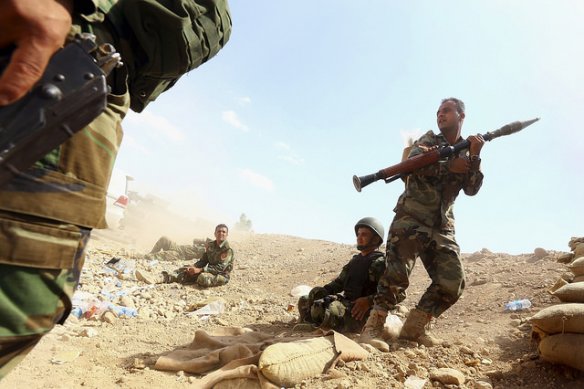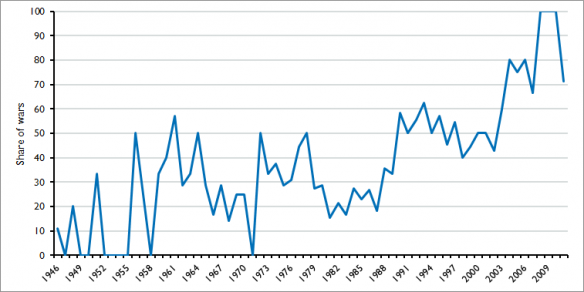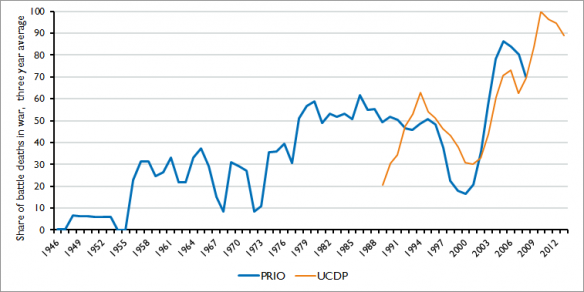The number of civil wars worldwide has fallen in recent years, but meanwhile the number of civil wars in Muslim countries is increasing.

Kurdish Peshmerga troops take part in security deployment against Islamic State. Photo via Flickr
From early on in the 21st century, we have also seen a marked growth in the number of active groups of Islamist insurgents. The media in Western countries focus strongly on terrorism and threats from the Muslim world. Are Muslim countries really more violent than others? And if they are, is it the West that is paying the price? In 2012, there were six civil wars worldwide (defining “civil war” as a conflict resulting in more than 1,000 combat-related deaths during a single calendar year). The countries affected were Afghanistan, Pakistan, Sudan, Somalia, Syria and Yemen. In other words, all of these wars were in Muslim countries, and seven of the nine insurgent groups actively involved were Islamist in orientation.
More violent?
If we look at the period from the end of World War II up to the present day, Muslim countries have been no more violent than countries with non-Muslim majorities. The main reason for this is that Muslim countries have been less involved in wars between sovereign states. The wars in Korea and Vietnam accounted for the highest numbers of casualties (a total of two million deaths). Muslim countries were not involved in these wars, with the exception of Turkey, which formed part of a wider UN coalition in Korea.
Since the end of the Cold War, there have been few wars between sovereign states. The international conflict picture is now dominated by civil wars and other internal conflicts. In the course of the past 50 years, we have not seen any sharp increase in civil wars in countries with Muslim majorities. Rather, the trend has been flat with minor rises and falls. But the decrease in other types of wars, such as wars between sovereign states and civil wars in countries with non-Muslim majorities, has caused the relative proportion of wars occurring in Muslim countries to increase.

Islamist rebel groups
Although the number of conflicts in Muslim countries has not increased, there has been a clear increase in the number of conflicts involving Islamist insurgents. This trend has been particularly noticeable since 11 September 2001, and the number is now greater than at the end of the Cold War. The table above shows civil wars that are occurring either in Muslim countries or where the insurgents are Islamists, as a proportion of all civil wars in the period 1946 to 2013. We see from this table that conflicts in Muslim countries and conflicts involving Islamist insurgents make up an increasing proportion of the overall conflict picture.
Not all Muslim countries are affected by civil war
The country with the largest Muslim population in the world – Indonesia, with over 200 million Muslims – has been free of armed conflict since 2005, with no occurrences of civil war since 1981. Of the 10 countries with the largest Muslim populations in the world, only three (Pakistan, Nigeria and Iraq) were affected by civil war in 2013.
None of the other seven (Indonesia, India, Bangladesh, Egypt, Iran, Turkey and Algeria) has experienced civil war in the last 10 years, although three have experienced internal conflicts on a smaller scale. The three Muslim countries affected by civil war account for 18 per cent of the world’s total Muslim population (according to figures from the Pew Research Center), while the other seven countries account for 49 per cent.
Victims of war
Currently the people most affected by war-related violence are those living in Muslim countries. So far the lack of information about the true situation in Syria means that the only estimate we have for combat-related deaths in 2013 so far is a so-called “low estimate” of 22,000. For other conflicts we apply a “best estimate”, which in the case of Syria is expected to be a much higher figure. In addition to Syria, the long-lasting conflicts in Afghanistan and Iraq account for the greatest loss of life. Recent examples are the attacks by IS on religious minorities in Iraq and Syria, and the massacre of 140 school children in Peshawar in Pakistan in December 2014. The table below shows the share of deaths in civil wars in Muslim countries between 1946 and 2013 compared to total deaths (figures from PRIO and the Uppsala Conflict Data Program). This shows that increasing numbers of conflict victims are people in Muslim countries. While there is an understandable fear of terrorism in many Western countries, the majority of combat-related deaths occur in Muslim countries among Muslims and members of religious minorities.

- A Norwegian version of this text was published in the Norwegian weekly newspaper Ny Tid 1 April 2015: “Islam og konflikt“
- Translation from Norwegian: Fidotext
Muslims are as peaceful as others,due to lack of democracy they are unable to resolve their internal conflict. It is duty of world community to help them. For this we have to stop to looking them as terrorist. They too want peaceful and joyful life.